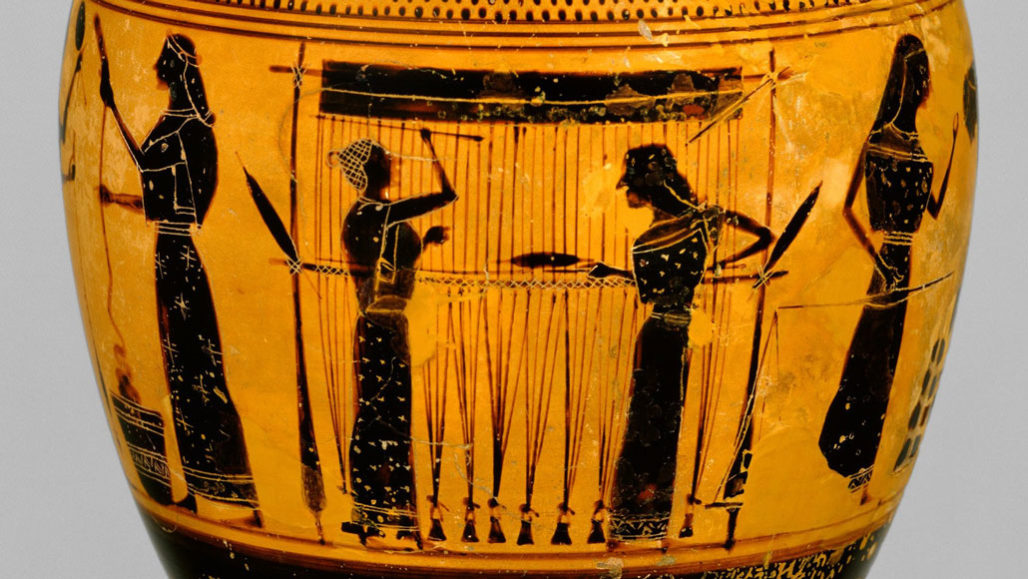…anulbaṇáṃ vayata jóguvām ápaḥ.
Weave ye the singers’ work without a knot.
—Rigveda 10.53.6
Those pale cream swaths of handmade linen, brought
From Sicily around 1905
Lay in our rag drawer over sixty years.
We kept them for whatever simple needs
Arose from time to time in household tasks:
A patch on some old garment, or a strip
Of lining to sew on a tattered hem;
A bit of bandage, or a cleaning cloth;
Wrapping for stored items, or just rags
Required for wipe-ups or for polishing.
I used the linen, tightly sewn and glued,
To reinforce the broken spines of books
And every volume so repaired now sits
Sturdy and strong on bookshelves. Though all gone,
Those linen swaths, like vanished, estranged friends
Haunt my remembrance and evoke regret.
We ripped it lavishly, as if the stuff
Were from an endless bolt’s eternal loom.
But why do otherwise? It was plain cloth,
No rarer than a dozen household goods
We used reflexively: old plates and trays,
Cookware, cutlery, and garden tools.
But I now think of women at their spindles
In warm Sicilian cottages suffused
With scent of oranges and candle-wax,
Twisting the flaxen fibers to form thread
And winding it on massive wooden spools
Sold to the patient weavers, whose swift hands
Sent shuttles running through the plaited weft.
These made the linen sheets. What year was that?
1885? Or 92?
No matter. They went into the trousseau
My grandma brought with her to Ellis Island,
And became bedsheets, lasting twenty years
Until they were consigned to our rag drawer.
By 1987 all was gone,
Save for those well-stitched bindings in my books,
Just visible at the edge of every spine.
And I think of roughly textured cloth
Smoothed by the steady rub of passing years,
But still as firm and tight as on the day
It came from the treadle-loom that gave it shape,
Weaving the fabric that would clothe our lives,
Our work, our sleep, our dreams, and our old books—
Textum for texts! What benison in this:
The generating spindle gives the thread
That shuttles through the womb of warp and woof,
And from that sacred union there is made
The garment of these sacramental words—
Mine, or the words of others, firmly bound
With spines of handmade linen. Can I feel
Its absence now, and not shrink inwardly,
Recalling a world far distant, but still loved?
The text and texture of identity,
The flaxen threads of what was, and still is,
Remain forever, and we cannot change
The spindle’s turn, the crisscross of the loom.
Give me the spinner’s skill, the weaver’s art—
The sure hand to make text well woven, firm,
Yet pliant as those linen swaths that lay
For sixty years in readiness to serve
Our home’s small needs and purposes. That wish
Hovers about my pen, and every line
I strive to set as straight and true and smooth
As those the loom and shuttle intertwined.
Joseph S. Salemi has published five books of poetry, and his poems, translations and scholarly articles have appeared in over one hundred publications world-wide. He is the editor of the literary magazine Trinacria and writes for Expansive Poetry On-line. He teaches in the Department of Humanities at New York University and in the Department of Classical Languages at Hunter College.















Is there anyone who can’t relate to this?
So very well done, Dottore.
Blank verse is the perfect form for this beautiful narrative poem. I love the musicality and richness of the language – especially the assonance. From the opening line’s “pale cream swaths of handmade linen”, to the closing, “I strive to set as straight and true and smooth/As those the loom and shuttle intertwined”, this piece held my mind captive. My favorite is the appeal to the senses with the women at their spindles in “Sicilian cottages suffused/With scent of oranges and candle-wax” – a sensory delight. The smoothness in which you’ve tied the art of linen-making into the art of poetry, and (dare I say it) recycling, is a triumph. Although, anything I have to say is wholly inadequate – the poem speaks for itself. Dr. Salemi, thank you for my Sunday morning smile.
Dr. Salemi, thank you for lighting up a gloomy day in England with this lovely, heartwarming piece. I will be re-reading this all evening. The last 8 lines are pure magic.
Lovely thoughts of times past and passing. While I read your words, I think of my memorable rag rugs, lovingly sewn piece to piece, over a century ago, lasting long beyond reason. Lovely words you weave your eternal linens. Thank you.
An unmistakable (and emphasized) image is the Italicized Latin word, “Textum.” It stands in the poem where the Canon begins in a Traditional altar missal, the “T” being the cross in a full page picture of the Crucifixion, and serving as first letter for the prayer “Te igitur” on the next page. And here we read religious and marital words–still applied to the extended image of woven “textum” or cloth, but alluding to the foundation and center of this remembered home in the Sacrament of Matrimony. It is hardly surprising that the author himself can “shrink inwardly” when facing this mystery, and all that proceeds from it. But neither is it surprising that this leads to the fervent force of the final stanza’s “Ite Missa est” and “Deo gratias.”
This is a beautifully written narrative for two main reasons.
Firstly, the sensory element of “scent of oranges and candle-wax” as Susan has highlighted, and the degree of detail provided for the uses of the fabric.
Secondly, the medium of simple woven cloth passing down through the generations provides association to craftsmanship, family, resourcefulness, and recognition of intrinsic worth. I am therefore saying that, consequently, this poem has depth and meaning that the reader can relate to on a number of levels.
Superlatives again fall low
When talking of the works of Joe.
These domestic, utilitarian insights are a foil to his social criticism and rigorous comments upholding poetic standards.
I too found ” warm Sicilian cottages suffused/With scent of oranges and candle-wax,” evocative and the sentence it is in takes us to an atmospheric and productive place that contemporary artizans would love to recreate.
Interesting how the use of digits for dates shrinks lines. So much here that it’s like a catch in the width of the sheet.
Dr. Salemi has a number of poetic tools in his desk drawer: For satire, a sharp pen of cold steel; for angry commentary, a pen of fire; and, for graphic sentiment, a painters brush which in this poem he wields with the skill of a master. I have come to like the paintings best, and this example equals the best I have yet read in that genre. Like the varnish that seals a finished oil, there is a patina of age-worn substance in these words—words which tell a story and create an image filled with enough vivid detail and intimate, personal reflection to warm my heart and stir the memories of the small things which have added so much meaning and value to my own life.
Joe, if your poems were pictures displayed in a museum, this would be the one I would revisit most often, for its exquisite beauty, unsurpassed skill, and its celebration of the ordinary things that make our lives extraordinary.
In the end, I suppose it boils down to a matter of taste. For me, this one is delicious.
Thank you all for your very kind and generous comments.
Mr. Salemi, one sees, is fond of the antique and antiques. Though their purposes contrast, I am reminded of the Baroque poet Edward Taylor’s “Huswifery”. Though Mr. Salemi seems well versed in 17th century verse (not Milton), his composition seams more like that of Thomson (1700-1743) or Wordsworth. The parts I like are the states and the strata, the dates and the data, and the ease of execution. [He is not fighting English tradition.]
Joseph,
What’s amazing to me about this poem is how you took something rater small and turned it into something quite large, all the while weaving into the poem’s tapestry the many details of domestic practicality, creating a strong sense of continuity, legacy, and plain-old family values. The use of a Sanskrit epigraph is a minor brilliancy in and of itself. As anyone with any familiarity with comparative linguistics will know, Sanskrit is near the base of the Satem branch of the Indo-European language family, while Modern English is at one of the tips of the Centum branch. To top it off, in the second course I took with Calvert Watkins, he developed the idea that parallel to the evolution of languages, there was a similar development of poetic language (and conventions). And so your epigraph completed the circle.
Upon each tiny colored thread
Hang all that lives and all that’s dead.
Dear Kip —
I deeply envy the fact that you studied with the great Calvert Watkins! I only dreamt of doing that. He was the dean of American Indo-Europeanists, and his books are still seminal. And I do know that he was especially adept at finding the parallels in poetic usage and diction throughout all the Indo-European languages. The phrase in Proto-Indo-European for “poet” is *wekwom teks” — the “weaver of words.” That particular formulation has always been in my mind, and it certainly was a major impetus behind this poem.
Mr. Anderson and Mr. Salemi bring up an important literature we should speak about @SCP more frequently and in greater depth: Sanskrit.
One of the reasons I deeply admire Sanskrit poetry is how it embraced so many areas of knowledge (including mathematics); and though I have fought off the sixteen syllable line, which I early indulged in, it is the shloka which pushed me decisively this last decade to the iambic heptameter.
Writing a poem this week on the Snow Leopard Op in “Himavat”, because of their brief personal communique, I was happily directed to Krishna. It is just such little tidbits that widen the vision of the “wekwom teks” that are so valuable to English poetic practice.
A great narrative with detail pitched in just the proper measure to delight the reader and not weary, having the space to breathe that it does. The Sanskrit epigraph was a bit afield for me, but I’m not at the stature of so many here. I’d have hoped for Latin so that it were nearer Sicily, if you will. Sanskrit and Latin do seem to have a lot of similar-sounding/looking words though (e.g. devas and deus) so there’s a glimmer for me.
In addition, this plays hugely into the etymology of weaving terms and written language terms– there’s a great episode about this on historyofenglishpodcast.com. The common heritage of lines and linen, etc.